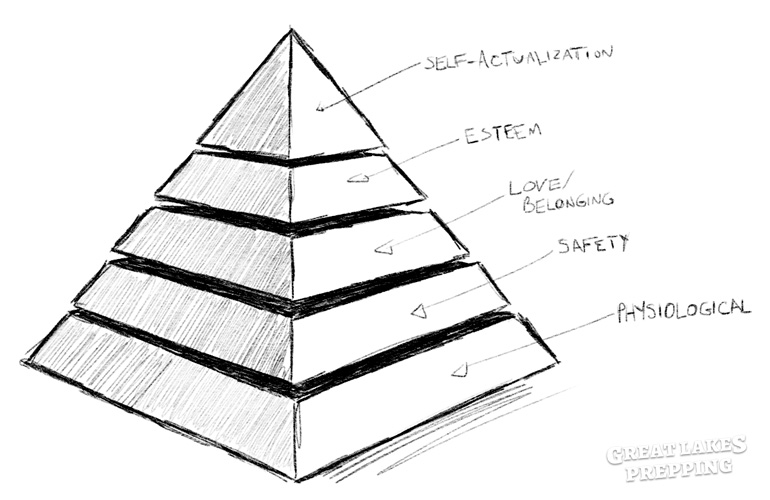Building a Prepper Community: Survival Community Overview

- Preface:
- Prepping for a Long-Term Collapse
- Chapter 1:
- Survival Community Overview
It’s not impossible to stay alive by yourself, with no other human resources to help you. It can be done. It has been done. People have survived, alone, in the middle of the wilderness since the dawn of mankind. That was once the way of the world. People were raised to develop the knowledge and skills needed to live off the land.
However, for a developed and modern place like present-day America, almost none of us have the skills, knowledge, physical capabilities, or frame of mind to suddenly begin fending 100% for ourselves. Most of us can’t do it, and most of us wouldn’t want to do it. We’re accustomed to our way of life full of structure and modern conveniences. We eat food that other people harvested, in homes that other people built. We drive to work in a car that took thousands of people to create and we plug away at our job where we are a tiny part of a larger operation. Sure, we still have blacksmiths and lumberjacks and true tradesmen. But the majority of Americans make a living from being a cog in the machine.
Many Americans make a living doing a job that will have very little practical use if civilized society collapses. The point I’m aiming to make is that we live in a society that has been built to rely on infrastructure, mass production, consumerism, and complacency. This is the nature of modern society as we’ve created it.
So what happens when the SHTF and our entire modern system of living no longer functions? We know the answer to that, and that is why we prep. But prepping alone isn’t going to make everything OK. While many preppers are incredibly dedicated and are going to fantastic lengths to secure their futures and their families’ futures should the worst happen, it’s not enough. Storing enough food and supplies for you and your family to live off of for ten years is amazing, but it’s not enough. Assuming you can keep looters and cut-throats away from your family and your supplies, you could survive. Assuming a natural disaster doesn’t destroy everything you’ve worked so hard to store, staying alive for years to come is a definite possibility. But “staying not dead” and “living” are two entirely different things.
I’ll use the prison analogy here: The most dangerous, horrible prisoners in a maximum security penitentiary can live in solitary confinement for decades. They are kept alive with food, water, and the most basic of physiological needs. From a security standpoint, they are also arguably the “safest” of any prisoner. But that is not “living,” according to any interpretation of the word that I believe in. Even the “general population” prisoners are able to have human interaction – even relationships. They can socialize, they can partake in recreational activities. Some of them are able to work and be productive and/or creative. The people who are in solitary confinement are deprived of any physical or psychological stimulation. They are experiencing the technical processes of having a living body, and that’s about it. Is this how your family wants to live out their days? Holed-up in a bunker, eating your five-thousandth freeze-dried meal from a sealed pouch?
I like the prison analogy, because it gives a rough idea of the concept I regularly preach. It’s not a perfect analogy, because I don’t necessarily like the idea of equating “survival” with “being in a prison”. Nevertheless, I consider it of utmost importance that if humanity must resort to a “survivalist” lifestyle as a result of a large-scale breakdown of modern society, our objective should not be to simply “survive.” Our objective should be to survive and thrive.
Hierarchy of Needs
In the 1940s, renowned psychologist Abraham Maslow published a paper that outlines what has come to be known as “Maslow’s Hierarchy of Needs”. For those who are not familiar with Maslow’s Hierarchy of Needs, I will explain. Maslow broke down and categorized everything that a human feels the “need” for in his or her lifetime. The Hierarchy is often presented as a pyramid-shaped chart. The idea is that the lowest (and thus widest) levels of the pyramid are the most basic needs. The most basic needs must be fulfilled before a person would consider the next level of the pyramid to truly be something that he or she needs.
Physiological
What do you need to physically stay alive? Every human needs oxygen, water, food, and protection from the elements (clothing, shelter, etc.).
Safety
Humans need to be safe and feel safe. This level can pertain to any part of the spectrum of feeling “safe,” be it security from physical danger, financial security, or anything in between.
Love/Belonging
If a human’s physiological and safety needs are fulfilled, a person will feel the need to “belong.” Generally speaking, unless people are starving or in constant physical danger, they long for the feelings of friendship, intimacy, family, and being loved.
Esteem
The next level of need that people feel is to be important. Who doesn’t like the feeling of being recognized for something at work or in a social circle? The need for esteem may include longing for status, fame, or attention. It may also materialize as a need for self-improvement (esteem for oneself).
Self-Actualization
I think it can be argued that many pursue this need, but almost no one truly fulfills it. The highest level in the Hierarchy of Needs is to accomplish everything that one possibly could accomplish. To do so would mean that, on your death bed, you could say to yourself, “I’ve done everything I could ever do, and I’ve become everything I could possibly become.”
Why do I bring up the Hierarchy of Needs? Let’s go back to the prison analogy. The solitary confinement prisoner has the two most basic levels of needs fulfilled (physiological and safety). But that’s it. That is living, but only according to the strict dictionary definition of the word.
Let’s talk about it from a point of view that is more practical to a scenario where people must live after SHTF. You can live in your bunker with your family, and eat your stored rice and canned meat. As long as you stay invisible and constantly alert, you can stay alive. This will be your life: Huddled in a safe-room, eating freeze-dried meals, sitting for potentially years on end in a state of constant fear and monotony.
This is how it will be if you intend to have your physiological and safety needs fulfilled with only yourself or a couple other people to rely on. The majority of preppers who I know are not planning to hide out in a bunker for years on end. They plan to grow gardens, filter rainwater, and possibly raise animals for meat. But if it’s only them and their small families to manage an operation like that, there are simply too many “wildcard” factors and loose ends that can lead to failure (and we all know what “failure of a survival plan” means). As humans, we want to have a life where we can pursue the fulfillment of all our needs. In order to do this, the “hide in a bunker” method is simply no option. Living and thriving means working, playing, growing, and loving with other people. Hypothetically this can be accomplished within one average family unit of three to eight people. But in a practical sense, this does not equate to enough “manpower” to maintain what will need to be maintained in a self-sufficient survivalist environment. A community is the only way.
The “Joe” Example
Let me lay out an example scenario that I believe is considered somewhat “ideal” to a lot of dedicated preppers:
Something has caused a panic among the population. Civil society is beginning to unravel as a result of some event (collapse of financial system, catastrophic power grid failure, class wars; choose your poison). A man (let’s call him Joe), his wife, and three children have bugged-out to their remote homestead. Since Joe has been a dedicated prepper for years, his family’s survival retreat is well-equipped and well-supplied.
On the property is a log cabin, outfitted with solar power, a wood-burning stove, and rainwater collection system. An outhouse has been constructed out behind the home. There is also a large storage shed next to the cabin, which easily holds the food, supplies, and water that Joe has prepared. Joe has stockpiled nonperishable food, water, and all essential supplies. With the stockpile alone, Joe and his family should be able to last for a couple of years before running out of anything. He has established redundancy for the most essential supplies, such as water filtration and heating appliances. The property is off the beaten path, a hundred miles from the nearest city, and consists of woodlands as well as a large, empty yard. The woods can provide for hunting, and the yard is perfect for an elaborate garden. Vegetable seeds, composting containers, and farming equipment have been accumulated and stored onsite. Joe even has a small coop full of chickens and a rooster, which can provide meat and eggs for years to come.
The homestead boasts an arsenal of weaponry for security and hunting purposes. Joe has a deer rifle, a couple of AR-15s, a 12-gauge shotgun, a variety of pistols, and crates full of ammunition for each weapon. Joe’s wife and oldest son also know how to use the firearms, and will play a role in security/defense measures if necessary.
Joe has supplies for medical emergencies, sanitation, and food prep. He has worked out processes for water filtration and food storage. Months’ worth of firewood, propane, and gasoline have also been gathered and stored. As someone who has been establishing my preparations for quite some time, this sounds like a pretty sweet setup. But as much time and money as Joe and his family have spent to procure supplies and stock their homestead with everything they need to live, there are a few major problems. All that hard work and money won’t be enough.
Sure, somebody like Bill Gates could build a Mega-Compound with state-of-the-art technology powered by geothermal energy, laser-guided aerial guard drones, on-site water processing facility, and an autonomous factory that turns trespassers into Soylent Green. If I had billions of dollars to spend on my doomsday survival compound, there is no limit to what I could dream up. If money was no object, then I could build a mile-high wall around a ten-thousand acre compound, with sentry machine guns and an entirely self-reliant utopia operated and maintained by my army of robot servants. But of course that isn’t realistic for me, and the probability is high that it’s not realistic for you. Joe’s setup is about as good as it gets for us regular folks.
So what are the problems that Joe faces with his survival retreat? He’s got supplies, food, water, weapons, etc. What could go wrong? Why would Joe and his family be better off in a community of 20-30 people than by themselves?
First and foremost, security is going to be an enormous concern. One skilled man with a rifle and a painfully-empty stomach is all that stands between a promising future for Joe’s family and absolutely no future. OK, I get that most people aren’t military snipers. How about a small team of raiders wielding pistols or machetes? In a situation where electronic-oriented technology is useless and law enforcement officers don’t exist, it would take only the element of surprise and/or a few determined individuals to completely overrun Joe’s homestead. It could take only moments for Joe’s survivalist utopia to become their survivalist utopia. It could take Joe and his family moments to go from sleeping peacefully to “resting in peace”. It’s a grim reality, but it’s reality. As I’ve said, there are few lines people aren’t willing to cross when they’re on the verge of starvation or dehydration. Even if Joe saw the bad guys coming and was able to get into a full defensive shooting position with his wife and oldest son, they are at a severe disadvantage. They’re pinned down. They are sitting ducks, and the bad guys know it. The best case scenario is killing the bad guys and not suffering any causalities. The best outcome of this attempted
invasion is that the homestead is successfully defended… this time.
Security concerns are perhaps the most severe in such an environment, but they are certainly not the only ones. Gardening is a full time job for a family of five. Gathering, filtering, and storing water is another full time job to satisfy the hydration needs of five people. How about hunting or tending to livestock? How much firewood needs to get gathered and chopped to make it through the winter months? Food prep, sanitation, and general maintenance are constant necessities. I don’t doubt that two determined adults, one teenager, and a couple of young children could take a noble stab at running a homestead in a situation like this. But there is so much left to chance. Even without constant security concerns, there is simply too much to be done by so few people.
The Two Principles
I’ve been attempting to answer the question, “Why would I need more people than my immediate family to successfully run a survival retreat?” Understanding the following two principles is key to realizing why operating as a community is so advantageous from a logistics standpoint.
Consolidation of Efforts
Several people can each do a smaller amount of work to achieve a goal that the entire group will benefit from.
Compounding of Efforts
Several people can accomplish proportionately more than fewer people (AKA: The whole is greater than the sum of its parts).
One person cannot do as much work, proportionately speaking, as several people. For example, try to move a couch from your basement to your living room all by yourself. I guarantee it will take more than twice the time and work than if you had a second person to help.
Two people can accomplish proportionately more than one person can. And twenty people can accomplish proportionately more than five people can. Instead of five families digging five separate latrines, everyone can pitch in and dig one latrine for all five families. Instead of five families building a fence around five properties, everybody can contribute and build one fence around one property. Do you see where I’m going with this? Instead of five individual families who are responsible for securing and patrolling five separate perimeters, five families together can be much more effective at patrolling one perimeter.
When it comes to surviving in an unforgiving world where the grid is down, technology and money are worthless, and the cavalry isn’t coming, you owe it to yourself and your family to give yourselves the best possible chance of success. Being part of a community that is working in consort towards a common objective is easier and more effective than going it alone.
Summary
A lot of preppers and survivalists don’t fully subscribe to the “community-based” methodology for a survival compound. Many of our like-minded brethren have adopted an, “If you aren’t me, you’re my enemy.” philosophy about the world post-SHTF. Plenty of folks have already made up their minds about how their survival operation should be run, and that is nobody’s business but their own. For those of you who are on the fence about the whole concept, here are the key points I want you to consider:
- If you want to survive and thrive, holing up in a bunker for the rest of your life is not an option.
- If you want to live and grow with your family through homesteading, it’s dangerous and incredibly difficult to do it alone.
- Being part of a larger survival community will provide social value (friendship, love, esteem, etc).
- Community efforts are consolidated and compounded, allowing for more people to achieve greater things while doing less work.
This article is part of a series of excerpts from the book, “Prepper Community”. All excerpts are used with explicit and exclusive permission granted by the author and publisher to GreatLakesPrepping.com.

